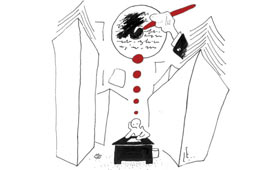
In an information-intensive world, readers of news need perspective. Journalists must have — or at the least, seek to acquire — a sense of history. For what is fresh news today is seldom an isolated event. We are all familiar with such truisms as “There’s nothing new under the sun,” and “History repeats itself.” How odd, then, to see Japan’s mass-circulation newspapers routinely treat events as startling, wholly unexpected, random, and seemingly unrelated to anything that has happened before.
The subjects that make news in Japan — crooked politicians, greedy gangsters, religious cults, shady businessmen and dysfunctional families — are as important to the Japanese as they would be to people anywhere else, just as the imperial family, earthquake preparedness and the nation’s reluctant re-examination of its post-bubble lifestyle are somewhat more domestically focused, but no less compelling.
Such topics should be the grist for diligent journalists seeking to help their readers to view the events of each day in a continuum and to understand how the pieces that make up a day’s news fit together into life’s great puzzle. Journalists should strive for a balance of curiosity, skepticism, integrity and respect for humanity, since reading a newspaper is an essential part of being prepared to deal with the increasing complexities of contemporary life. But reading a paper in Japan presents a special challenge, because handicaps and difficulties confront readers who seek the whole story and hope for clues about its broader meaning.
In the best of Western reporting, the emphasis is on what is called public journalism — consumer-oriented, service-oriented, what-does-it-mean-to-me reporting. In Japan, however, readers are largely left to themselves to puzzle out the intent and significance, and don’t always appreciate these until it is too late.
Japanese, like news readers elsewhere, have become more sophisticated, diverse and complex in their interests and news needs. Trying to keep them from drifting off to TV, the Internet or the scores of new niche magazines, the mainstream Japanese press has, like its Western counterparts, resorted to entertainment, titillation, bombast and trivialization far more often than balance, perspective, or insight. For all its media access, Japan is overfed and undernourished.
In fairness, a daily newspaper is restricted by both deadlines and space in what it can contain in a single edition. If 60 percent of available space must go to advertising, editors are forced to make tough decisions about how much of the ‘news hole’ can be devoted to background and perspective. In Japan’s newspapers, however, such difficult decisions are often arbitrary. Readers do not always have the memory or the resources to recall past events that bear on current news. But they will be disappointed if they expect their newspapers to bring them up to speed.
Consider, for example, the newspapers’ coverage of the release by Tokyo’s Metropolitan Government of a report, based upon the opinions of well-credentialed experts, which suggested blithely that no more than 7,000 people would die in a central Tokyo earthquake similar to the one that devastated Kobe in 1995. Stories merely repeated the gist of the report, with scant effort to balance its assertions against other independent studies which suggest far more ominous scenarios.
Unfortunately, Japan’s systems for addressing disaster are not much better now than they were in ‘95, and the nation’s newspapers are not addressing those inadequacies in print. They have fallen far short of their civic obligation. Questions that should have emerged from the Kobe quake deserve to be addressed. Privately, I have been told that editors, especially senior news editors in Tokyo newsrooms, sought to downplay the Kobe disaster, hoping to present it as a regional event, in the larger interest of “avoiding nationwide panic.” Indeed, this editorial policy could be construed as in keeping with the Nihon Shimbun Kyokai ’s credo of trying not to ‘sensationalize’ news.
But how many people might have survived the ‘95 quake, which killed 6,500, if a central disaster-response effort had been immediately mobilized? What has been done since then to establish such a coordinated effort? And for that matter, how much of the money annually spent on “disaster preparedness” is actually used to prepare and maintain the means to shelter and care for victims of the earthquakes, volcanic eruptions, typhoons or tsunami that are all probabilities in Japan? Newspaper readers should be getting answers to questions like these, but seldom even see them raised.
Japan is stumbling out of the hangover left by a long binge of asset-inflation speculative investment, an economic nightmare brought on by lending practices that were not only bad business but patently illegal. Taxpayers are still being asked to absorb the multi-billion yen burden of paying off the bad loans. Have any newspapers asked why, or seriously investigated how much real housing was ever developed by the companies that failed?
All too often, when a corporate executive is caught giving bribes or seeking, at the public’s expense, to improve his company’s competitive advantage, the executive resorts to the ritual of resigning “to take responsibility,” and is usually kept on the payroll in some advisory or titular capacity. Why aren’t such wrongdoers made instead to repent, clean up their messes, and face prosecution? Newspapers don’t ask.
Even so, many of Japan’s readers are awakening to an uneasy sense that the mainstream press is not giving them the whole picture, and that somehow their newspapers are not as vital as they used to be. Readers long loyal to their papers, along with young people who have never picked up the habit, are turning elsewhere for information and enlightenment. This is unfortunate, because the gap between newspapers and the Japanese public could and should be narrowing.

